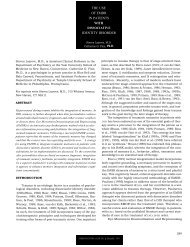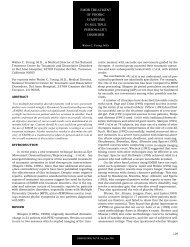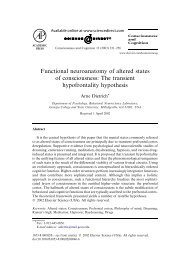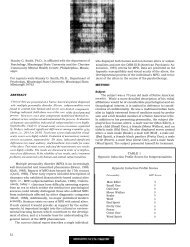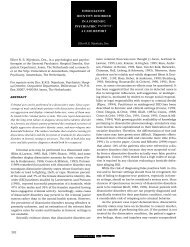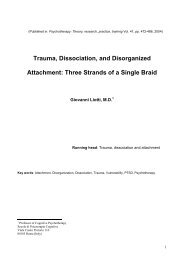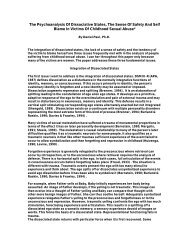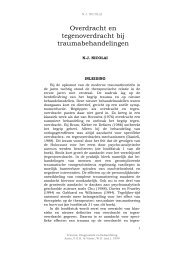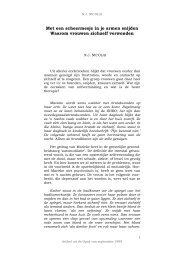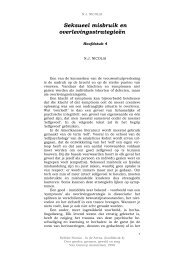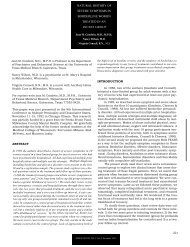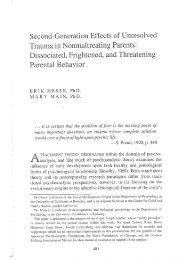sadistic abuse: definition, recognition, and - empty memories
sadistic abuse: definition, recognition, and - empty memories
sadistic abuse: definition, recognition, and - empty memories
Create successful ePaper yourself
Turn your PDF publications into a flip-book with our unique Google optimized e-Paper software.
SADISTIC ABUSE<br />
first used to describe these new clinical situations. From the<br />
beginning, there have been problemswith the term. Itemphasizes<br />
religious or pseudo-religious practices rather than the<br />
extreme violence that lies closer to the center of the clinical<br />
experience. As a new term, " ritual <strong>abuse</strong>" implies a new<br />
reality rather than a phenomenon indigenous to human history,<br />
a phenomenon that can be placed on a continuum of<br />
severity of <strong>abuse</strong> <strong>and</strong> sequelae, <strong>and</strong> connected to bodies of<br />
extant knowledge <strong>and</strong> research about other types of physical<br />
<strong>and</strong> sexual <strong>abuse</strong>. The term ' s connotations of the religious<br />
<strong>and</strong> the occult have led to a search for data about "ritual<br />
<strong>abuse</strong> " in the history of religions, rather than in the history<br />
of family violence, political torture, crime <strong>and</strong> sexual perversion.<br />
To believe a patient's account of "ritual <strong>abuse</strong>" has<br />
become subtly connected to a propensity for belief in secret<br />
religious conspiracies or in the magical powers of witches<br />
or spirits. Questions have arisen about whether clinical work<br />
in this area might infringe on basic religious freedoms.<br />
The author (Goodwin, 1993) has proposed substituting<br />
the older term "<strong>sadistic</strong> <strong>abuse</strong>" <strong>and</strong> reserving "ritual <strong>abuse</strong>"<br />
only for subtypes of <strong>sadistic</strong> <strong>abuse</strong> in which pseudo-religious<br />
or cult elements predominate. Sadism was defined by Freud's<br />
mentor, Krafft-Ebing (1894/1965), in the Nineteenth<br />
Century, as follows: "The experience of sexual or pleasurable<br />
sensations...produced by acts of cruelty, as bodily punishment<br />
inflicted on one's own body or witnessed in others,<br />
be they animals or human beings. It may also consist of innate<br />
desire to humiliate, hurt, wound, or even destroy others..."<br />
Krafft-Ebing's seven editions of Psychopathia Sexualis constitute<br />
an encyclopedia of clinical accounts of extreme <strong>abuse</strong>,<br />
mostly drawn from perpetrators rather than from victims.<br />
No element found in contemporary accounts is missing from<br />
this Nineteenth Century text, published in Latin to deter its<br />
use as a h<strong>and</strong>book for <strong>sadistic</strong> perpetrators. Death threats,<br />
use of religious settings <strong>and</strong> costumes, bodily mutilations of<br />
all sorts, bondage, use of excretions <strong>and</strong> blood, animal torture,<br />
<strong>and</strong> cannibalism - all are well described not only in<br />
Krafft-Ebing, but also in the works of the Marquis de Sade<br />
who lived one hundred years earlier <strong>and</strong> whose name Krafft-<br />
Ebing gave to these behaviors.<br />
Careful study of de Sade <strong>and</strong> other sadists can broaden<br />
our approach to the study of extreme sexual <strong>abuse</strong>. The<br />
Marquis de Sade (1789/1987) was a famous Eighteenth<br />
Century libertine, sexual criminal, <strong>and</strong> pornographer. He<br />
developed a philosophy largely devoted to rationalizing his<br />
<strong>sadistic</strong> deeds, by claiming sexuality as the fundamental motivation<br />
of natural man. He spent most of his adult life imprisoned<br />
for <strong>sadistic</strong> crimes. He poisoned the inhabitants of a<br />
brothel with aphrodisiacs, tortured a prostitute in his private<br />
chapel, abducted <strong>and</strong> tortured a beggar, <strong>and</strong> sexually<br />
abducted his wife's younger sister. Even while incarcerated,<br />
he continued to pay mothers to bring him their daughters<br />
as sexual victims; bones were found in his castle garden,<br />
probably from sexual victims who died "accidentally" during<br />
<strong>sadistic</strong> orgies (Dworkin, 1981). It was in prison that he<br />
began his career as a writer of <strong>sadistic</strong> pornography. He denied<br />
personal sexual interest in homicidal sadism <strong>and</strong> necrophilia,<br />
although he wrote about such practices; indeed, when<br />
he was recruited as a judge in the aftermath of the French<br />
Revolution, he refused to execute prisoners on grounds that<br />
the guillotine did not excite him sexually.<br />
The case of de Sade as well as other cases collected by<br />
Krafft-Ebing would lead us to look for extreme <strong>abuse</strong> not<br />
only in pseudo-philosophic cult contexts, but also in criminal<br />
contexts, in the worlds ofprostitution <strong>and</strong> pornography,<br />
in extreme family violence, <strong>and</strong> also in settings of political<br />
<strong>and</strong> institutional torture. Use of this broader behavioral category<br />
(Durkheim, 1895/1984) facilitates both cross-cultural<br />
<strong>and</strong> historical comparisons.<br />
TERMINOLOGY: TERRORIZATION<br />
VERSUS PROGRAMMING<br />
As we access earlier research about sadism, recent<br />
accounts of perpetrators' attempts to gain mind control over<br />
their victims come into contextual focus. As Krafft-Ebing<br />
noted, emotional terror <strong>and</strong>successful deception are as important<br />
to sadists as is the infliction of bodily harm. One study<br />
found that the victim ' s facial expression of pain <strong>and</strong> terror,<br />
achieved by whatever means, provided the sadist ' s most direct<br />
source of satisfaction (Heilbrun & Seif, 1988) . As a <strong>sadistic</strong><br />
serial killer put it: "The pleasure in the complete domination<br />
over another person is the very essence of the <strong>sadistic</strong><br />
drive " (Dietz, Hazelwood, & Warren, 1990). Careful interviewing<br />
of sadists <strong>and</strong> their victims indicates that many methods<br />
are used to achieve total domination or "soul murder"<br />
(Shengold, 1989) of the victim. Such methods, used by political<br />
torturers as well as by criminal sadists include: control<br />
of basic bodily functions as eating, sleeping, <strong>and</strong> elimination;<br />
physical beatings; physical torture; psychological torture;<br />
control of information <strong>and</strong> misinformation, confinement<br />
<strong>and</strong> sensory deprivation; rape <strong>and</strong> genital mutilation;<br />
witnessed violence <strong>and</strong> threats; forced labor <strong>and</strong> poisoning.<br />
Gelinas (1993) has used the term "malevolence" to describe<br />
the emotional <strong>abuse</strong> found in these contexts. Induction into<br />
violence is an ultimate technique <strong>and</strong> test of this process in<br />
which an initial victim recruits new victims <strong>and</strong> eventually<br />
becomes a co-perpetrator.<br />
This review proposes "terrorization" as a descriptor for<br />
<strong>sadistic</strong> efforts to gain absolute levels of control. "Programming"<br />
would be reserved for the subgroup of terrorization tactics<br />
involving combinations of modern hypnotic, behavioral, <strong>and</strong><br />
psychopharmacological techniques. Terrorization has been<br />
described in situations of extreme family violence, in holocaust<br />
<strong>and</strong> other prison camp settings, <strong>and</strong> in hostages <strong>and</strong><br />
other victims of political torture (Goldfield, 1988).<br />
HISTORICAL EXAMPLES OF<br />
SADISTIC PERPETRATORS<br />
De Sade is not the only sadist in history whose career<br />
combined criminality, family violence, political violence, the<br />
creation of a pseudo-religion, <strong>and</strong> involvement in pornography<br />
<strong>and</strong> prostitution. Caligula (Suetonius, c. 120/1979)<br />
is described as marrying his sister <strong>and</strong> then killing her after<br />
she became pregnant. He is said to have delighted in watch-<br />
182<br />
1}1S50C1.1TI0X. AW. VI. No. 2: 1 June &pt.1993



